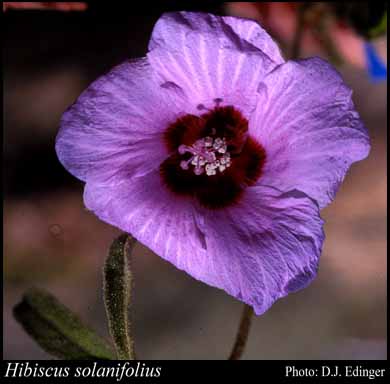- Reference
- Fragm. 2:116-117 (1861)
- Conservation Code
- Not threatened
- Naturalised Status
- Native to Western Australia
- Name Status
- Current
Shrub, 0.3-1.3 m high. Fl. pink/purple, Jan to Oct. Red sand, stony soils.

Scientific Description
Shrub or tree, with hairy stems. Leaves 30-40 mm long, 8-30 mm wide, tripartitely lobed, simply (once-)lobed; margins entire; hairy, with stellate hairswith scales absent, Sessile glands absent; stipules present but early deciduous (only visible on youngest leaves), 11-13 mm long. Perianth clearly of two whorls (calyx and corolla), the corolla obvious and prominent. Pedicel present, 10-35 mm long; indumentum present, with stellate hairs present, with scales absent. Epicalyx (extra segments or 'bracteoles' immediately below the calyx) present, 5-6 mm long, the lobes free, indumentum present, stellate hairs presentwith scales absent, Sessile glands absent. Calyx green, 11-15 mm long, the lobes fused less than half their length, Sessile glands absent, simple hairs (without tubercle bases) absent, stellate hairs present, tubercle-based simple hairs absent, gland-tipped hairs absent, scales absent, Terminal appendages absent, number of ribs absent. Corolla pink or purple, 27-40 mm long, glabrous. Indumentum (outside) Sessile glands absent. Stamens many, united and arising from a staminal tube around the style; filaments present, 0.5-0.6 mm long; anthers 0.7-1.2 mm long, indumentum absent (anthers glabrous). Staminodes absent, appendages absent. Ovary hairs or scales present, simple hairs present, stellate hairs absent, gland-tipped hairs absent; style 1, 12-15 mm long, with five style branches or lobes, mostly glabrous, wing absent. Fruits dehiscent (capsules and follicles), length-width ratio more or less as long as wide, hairs or scales present, simple hairs (without tubercle bases) present, stellate hairs absent, Sessile glands absent, tubercle-based simple hairs absent, gland-tipped hairs absent, scales absent; apex rounded; prickles absent (except perhaps a terminal awn); terminal awns or spines absent; calyx persistent to mature fruit; seeds per loculus 2-4. Flowering time January, February, March, April, May, June, July, August, September or October. Distribution Botanical Province Eremaean, IBRA Bioregion Central Ranges, Murchison and Coolgardie.
Distribution
- IBRA Regions
- Central Ranges, Coolgardie, Little Sandy Desert, Murchison.
- IBRA Subregions
- Eastern Goldfield, Eastern Murchison, Mann-Musgrave Block, Trainor.
- Local Government Areas (LGAs)
- Coolgardie, Kalgoorlie-Boulder, Leonora, Ngaanyatjarraku, Wiluna.